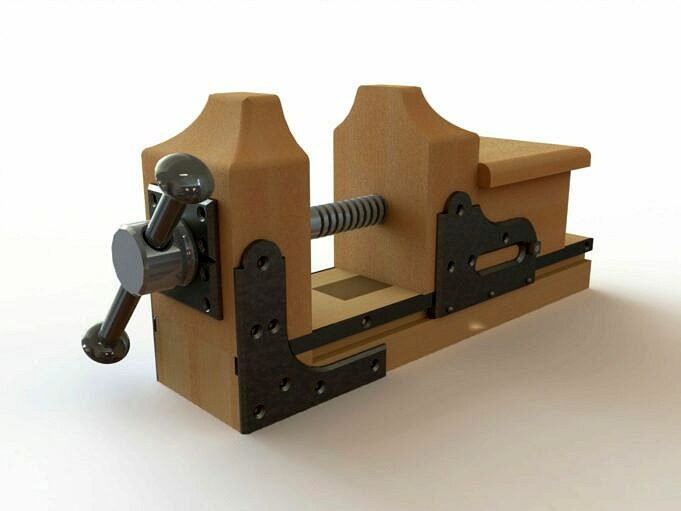17th-century design saves your 21st-century back.
pages 64, 66
If you cut dovetails by hand, then Im sure youre aware of the other part of your anatomy that is involved: your back.
Bending over rows of tails and pins all day is murder when you try to stand up straight. Many people have found solutions. One is a mini-bench, which you can park on top of your regular-sized bench to elevate your work. Other woodworkers have built benches with higher benchtops that are designed just for hand-joinery.
As with most things in woodworking it is likely that someone already had the solution many centuries ago.
Mechanick exercisesJoseph Moxon was the author of The Mechanick Exercises, an English-language book about woodworking published in 1678. In it he showed many of the tools used by the contemporary joiner, from the workbench down to the dividers.
In one part of his book he discusses the double-screw vise. It looks like a twin-screw vise with two jaws that has been affixed to the front of a workbench.
The text also discusses how to clamp the vise down to the top edge of the workbench.
When that piece of information sunk in, I got excited and built a prototype. Here’s what I came up after a few more revisions.
This vise solves many problems we joiners face. This vise allows you to hold stock in any size, (mine can hold material up to 24-120cm wide) and has an amazing grip. It raises your work from the benchtop. The vise as shown is 15 cm high, so the top edge of the vise is 99 cm from the floor.
I have clamped the board in the vise at 112 cm above the floor. It is as stable and solid as something that is clamped between two boulders. What does this mean?
You won’t have to stoop any more to see dovetails, pins, or other joinery.
Tap then tap. Place the front jaw on your rear jaw. Drop your Forstner in the hole. Tap it with a hammer. Then drill the hole in the rear jaw and tap that.
And because the vise is portable, that means I can:
1. Put the vise wherever I want on the bench the end, the back edge, wherever.
2. It can be taken out when it is not needed and hung on the wall. Most woodworkers don’t need a twin-screw vice every day.
3. You can leave it unclamped on your benchtop and use it as a huge handscrew clamp. (Peter Follansbee helped me with this function).
The vise is quite easy to build I used some scraps. A 1-15 cm wooden threadbox and tap are the other essential piece of equipment in a shop. They can be purchased at many suppliers for as little as 0.
Tap the Jaws
The first step is to cut the 1-15 cm-diameter clearance holes in the front jaw. The holes should be placed so that there are 24-120 cm between them. Then center the front jaw on the rear jaw and clamp them together. (Note: The front jaw is wider than the rear jaw so that it is easier to line up the rear jaw with the front edge of your benchtop.)
Two screws in one. The two vise screws are made from one octagonal piece. Reduce the middle. Cut the piece in half. Thread the round sections.
Drop a 1-15 cm Forstner bit into each hole and tap the end with a hammer this transfers the centerpoint of the hole to the rear jaw.
Unclamp the jaws and drill 1-320 cm holes though the rear jaw. Then use your tap to tap the holes in the rear jaw (a little linseed oil or a non-drying vegetable oil makes a good lubricant).
Turn and Thread the Screws
Vises screws are 5 cm x 5-cm walnut. I planed a 64 cm-long section to an octagon then chucked that in the lathe. The 36 cm middle was reduced to 1-15 cm. Then, I cut the piece and created two handles measuring 12-15 cm.
Clamp a vise screw with the round section facing up and use your threadbox to thread the round section. Check the result in the rear jaw. If the screw squeaks or doesnt turn freely, adjust the cutter in the threadbox so it cuts slightly deeper.
Add the Rear Brace
A rear brace can be glued to the backside or the jaw of your rear jaw. This will make the vise more stable and increase the area that touches your bench. Glue and clamp the rear vise in place.
Add some details if you like. I chamfered the front edges of my front jaw and the ends of the vise screws. I gave the vise screws a few coats with oil/varnish mixture. I added a layer suede to the inside of the front jaw. This improves vise grip.
Ive been testing the vise for more than three months (and I made versions for co-workers and friends). If you cut dovetails, I think this vise is well worth making. Your back will thank me. PWM
Download the PDF below to see the cutlist and plan illustrations.
MoxonBenchVise



